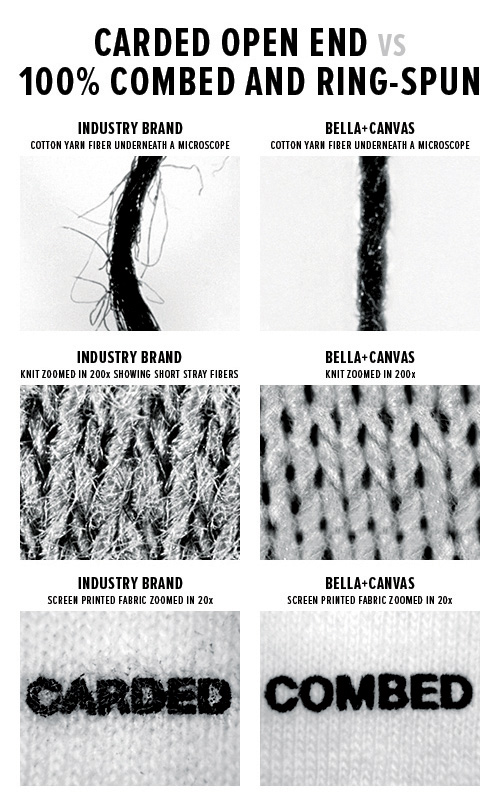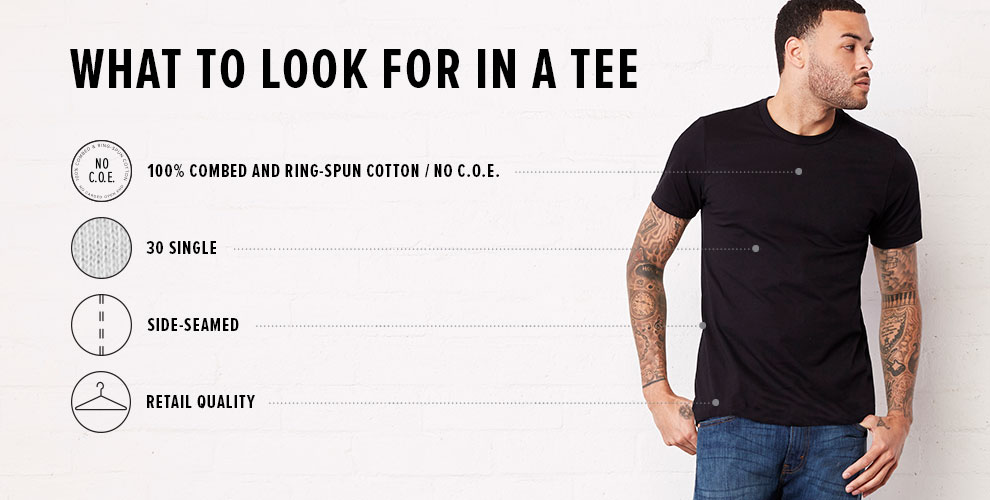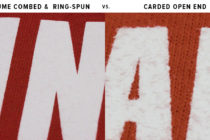There are an endless number of factors that can differentiate one tee from another. Two seemingly identical tees can be very different types of t-shirts when you dissect what goes into the construction all the way down to the thread level. How a tee is made has everything to do with the feel, fit, durability and printability. We break down the different elements of a tee you’ll want to pay attention to so you can ensure you’re getting the right blank t-shirts for you and your business.
Carded Open End vs. Ringspun
Ring spun cotton is smoother and longer than open end yarn. The term “ring spun” means that the yarn goes through an innovative spinning process that’s designed to thoroughly soften and straighten each fiber. The result? Softer, more refined fibers (aka pieces you want to wear). Want something even softer? Combed and ring-spun cotton, the kind that BELLA+CANVAS uses on all our tees means that cotton fibers are spun then combed through to remove impurities while ensuring it stays soft to the touch. Fewer impurities mean a smoother surface to print on.
Carded open-end is a cheaper way of turning cotton into yarn. In this method, fibers are bound by a wrapped fiber that runs perpendicular to the bundle, whereas In ring-spun cotton, all of the fibers are aligned in the same direction. Up close you can see that carded open end fiber is bulky, fuzzy and creates an uneven knit.
The industry standard used to be a carded open-end tee, but at BELLA+CANVAS, we do things differently. We promised never to sacrifice quality for price and only use cotton that is 100% combed and ring-spun. As people become more educated in in fabric and feel the difference in quality we see customers moving out of that carded open end tee and into BELLA+CANVAS.
Side-Seamed vs. Tubular
Side Seams create the tailored structure a tee needs to fit correctly. Although pricier to make, these are the only type of tees you’ll find in a retail store. They also happen to be the only type of tees you’ll find at BELLA+CANVAS.
Tubular Tees are cheaper to manufacture because they require less sewing. They are made by cutting “tubes” of fabric, so they’re exactly the same in the front and the back, aside from the neck drop. Because of this, and the fact that our bodies are not tubes, these types of tees tend not to fit right.
Singles and Weight
Single is a term that refers to the diameter of a yarn, determined by number of times you twist the fiber. The higher the single, the finer the yarn and the softer resulting garment. Think of it like you do sheets—a higher thread count means softer the sheets! Most cheap shirts are made from 18 or 20 singles. All of our tees (aside from our Heavyweight Street Tee) are 30 singles or higher!
Weight, as you can probably guess, is the weight of per square yard or meter. Lighter fabrics tend to be made from combed and ring-spun cotton and are typically much softer than the heavy weight, open-end alternatives.
Now you can navigate the market like a pro! What’s the number one factor you look for in a tee?





46 Comments
Betty
Very interesting. I literally see thousands of t-shirts every month as we make T-Shirt Quilts from user t-shirts. Most of these shirts have been worn/laundered over many years. Some tees are soft and still feel like new, others look like they have been dragged behind a truck. I will look closer to see what brands the shirts are.
Betty
http://www.TShirtQuiltsTX.com
Naman Kumar
yo, these t shirt quality are actually really good.
Hope to see more new products soon
BELLA+CANVAS
Glad you like them!
Alex Vargas
In this context, does the word “single” in 30 single means single jersey?
BELLA+CANVAS
Hi Alex! Single is a term that refers to the diameter of a yarn, determined by number of times you twist the fiber. The higher the single, the finer the yarn and the softer resulting garment. Think of it like you do sheets—a higher thread count means softer the sheets! Most cheap shirts are made from 18 or 20 singles. All of our tees (aside from our Heavyweight Street Tee) are 30 singles or higher!
Nicole
I am trying to decide what size shirt to order for myself. I have never heard of the 100% airlume combed and ring spun cotton or the 90/10 airlume. Do I need to worry about shrinking or will this type of shirt stay true to size?
BELLA+CANVAS
Hi Nicole! We’re so glad you found Bella+Canvas!
Our shirts are made with the most high standards and are all pre-shrunk to guarantee your garments stay true to size, even after washing!
Amy liu
Very useful article, all of the opinion is right.
Thanks for Danny and Marco.
Just about singlets, i do not understand this word too.
May i guess this word is it meaning of yarn count? And is it always abbreviated” S “?
Could you reply me this question?
Thanks
Amy
BELLA+CANVAS
Single is a term that refers to the diameter of a yarn, determined by number of times you twist the fiber. The higher the single, the finer the yarn and the softer resulting garment. Think of it like you do sheets—a higher thread count means softer the sheets! Most cheap shirts are made from 18 or 20 singles. All of our tees (aside from our Heavyweight Street Tee) are 30 singles or higher!
my.desktopnexus.com
I like what you guys are up also. Such clever work and reporting!
Keep up the excellent works guys I have incorporated you guys to my blogroll.
I think it’ll improve the value of my site :).
The Taj Mall
Be Different. Just your name your content is also different. really impressed.
Also, the quality really matters and especially of the printed t-shirts.
You can also check out the link below for some cool printed t-shirts.
https://www.thetajmall.com/product/gangster-google-logo-t-shirt
printlandokhla
Nice article keep it up like this in your future.I hope you do best afford and make future bright.
BELLA+CANVAS
Thanks so much for your positive feedback! We’re glad you enjoyed our blog. Feel free to check back for more blogs to come each week!
FelixSLISA
Hi, I find reading this달팽이게임 article a joy. It is extremely helpful and interesting and very much looking forward to reading more of your work
BELLA+CANVAS
Glad you found it helpful!
StephenBut
Hello!
So, you may have different reasons for using a dissertation service. However, in all situations the result depends upon the quality of a company you choose. If you want to be sure about happy ending, you may want to choose a trusted site from the following list of top 20 dissertation writing services.
http://wildfire-pro.com/Forum/viewtopic.php?f=16&t=449370
essay on the help
andini vitrya
Nice article keep it up like this in your future.
easy to understand
BELLA+CANVAS
Thanks for the positive feedback 🙂
teespringcovid19
Thank you so much for sharing this. This is a very informative blog. You are the best!
BELLA+CANVAS
Amazing! Thank you so much for the positive feedback!
https://gitlab.com/senerview20
That is really fascinating, You are an overly professional blogger.
I have joined your rss feed and stay up for in quest of extra
of your excellent post. Also, I’ve shared your site in my social networks!
Here is my blog post: exam dumps (https://gitlab.com/senerview20)
BELLA+CANVAS
Thanks so much for the positive feedback! We appreciate it:)
https://framagit.org/amiralg42
Hi there very cool web site!! Guy .. Beautiful ..
Superb .. I will bookmark your site and take the feeds additionally?
I’m happy to seek out so many useful information right here
in the put up, we’d like develop extra strategies on this regard, thank
you for sharing. . . . . .
Feel free to surf to my web-site answers (https://framagit.org/
BELLA+CANVAS
Thank you for the positive feedback!
clck.ru
I like what you guys are up too. Such smart work and reporting!
Keep up the excellent works guys I have incorporated you
guys to my blogroll. I think it will improve the value of
my website :).
Here is my page – wiring (clck.ru)
BELLA+CANVAS
Thanks for the kind words! 🙂
Violet
I believe you have noted some very interesting points, thanks for the post.
Check out my web blog; exam (Violet)
BELLA+CANVAS
Thanks so much!
corta.co
I don’t normally comment but I gotta say thank you for the post on this one :D.
Here is my web-site; schema (corta.co)
BELLA+CANVAS
Glad you enjoyed our post!
shorturl.at
Wonderful work! This is the kind of info that are supposed to be shared around
the web. Shame on Google for no longer positioning this post higher!
Come on over and discuss with my site . Thank you =)
My blog post: test (shorturl.at)
BELLA+CANVAS
Thank you! We appreciate the positive feedback!
Linda
Great post! I always prefer Bella canvas t-shirts for my clients. Their fabric quality was too good and responsible also.
Jeffery Ollsan
That’s a great piece of information about fashion and look. I love to share and seek about fashions tips and ideas. Thanks for sharing your valuable ideas with us. Keep it up.
Nick Williams
Amazing article, Love reading this. Thanks for sharing with us.
Certificate Attestation Kochi
Thanks for sharing with us.
workers compensation lawyers
That’s a great piece of information about fashion and look. I love to share and seek about fashions tips and ideas. Thanks for sharing your valuable ideas with us. Keep it up.
Drilling e-learning
Thanks for sharing your thoughts. I truly appreciate your efforts and I will be waiting
for your next post thank you once again. Drilling e-learning
Dylan Ryan
That is an incredible snippet of data about style and look. I love to share and look for about styles tips and thoughts. A debt of gratitude is in order for imparting your significant plans to us. Keep it up.
NF Merchandise
This article is written on original facing issues. Thanks for sharing
vlone brand
This site is amazing and helpful
BELLA+CANVAS
Glad you are enjoying our blog!
Travis scott merch
amazing post i am very happy to post. thanks for sharing such a super article